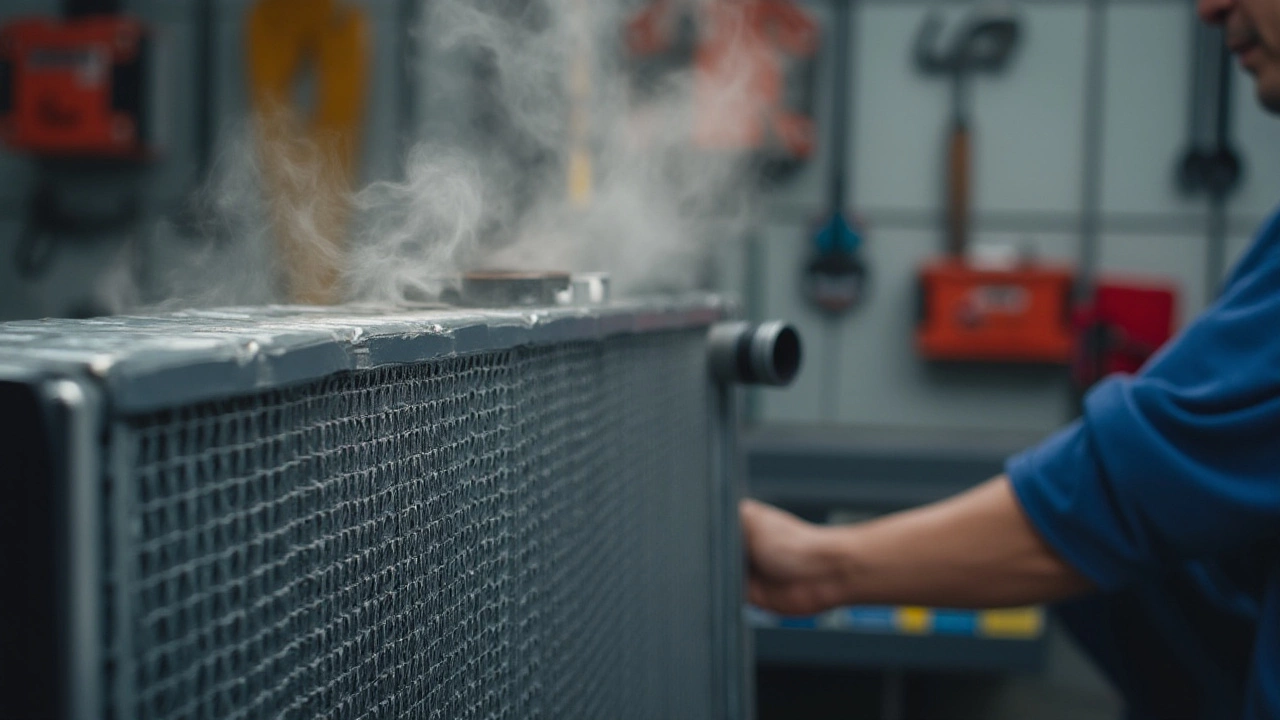When a car's cooling system is under stress, a radiator can develop cracks. This issue might seem trivial at first but can escalate to severe engine damage if not dealt with swiftly. Recognizing the signs of trouble early on is key.
Over time, wear and tear or sudden impacts can lead to radiator damage. Many drivers face the dilemma of opting for a quick fix or professional repair. Both methods come with their pros and cons, influenced by the severity of the crack and driver expertise.
Learning about the different repair methods available can help you make a choice that saves both time and money. Additionally, adopting preventive care habits is vital in minimizing future radiator problems. Keep reading to get deeper insights into how you can keep your car running smoothly without breaking the bank.
- Understanding Radiator Cracks
- Identifying Symptoms of a Damaged Radiator
- DIY Repair Methods for Radiator Cracks
- Professional Solutions and Costs
- Preventive Measures and Maintenance Tips
Understanding Radiator Cracks
Radiators are crucial components of a vehicle's cooling system, responsible for dissipating heat away from the engine. Over time, various factors can contribute to the formation of cracks within the radiator, making it essential to understand the dynamics at play. Cracks often result from prolonged exposure to temperature fluctuations. When a radiator repeatedly heats and cools, the material expands and contracts, creating stress that can eventually lead to damage.
Material fatigue isn't the only culprit, though. External damage is another common reason for a cracked radiator, whether from debris kicked up during a drive or an unfortunate fender bender. Even minor collisions can compromise radiator integrity. Most modern car radiators are made of aluminum and plastic, which, while effective for heat transfer and weight reduction, can be more prone to cracking than older copper or brass models. Understanding these elements is vital when assessing the root cause of the problem and determining the right repair strategy.
Pressure inconsistencies within the cooling system can also play a significant role. The system operates under pressure to maintain optimal temperature control, and if a malfunction occurs, it can lead to increased stress on the radiator. A radiator cap failing to release pressure adequately, or a thermostat stuck closed, may exacerbate crack formation. Not to mention, the coolant itself, if left unchanged over extended periods, can turn acidic and begin to corrode the radiator materials, facilitating cracks.
Regular maintenance and inspections can help catch early signs of trouble, reducing the risk of significant repairs in the future. According to automotive expert John Smith, "A well-maintained radiator is less likely to suffer from cracking; keeping the cooling system in check is a small effort for prolonged engine life." This proactive approach can prevent sudden breakdowns and unexpectedly high repair bills.
Interestingly, radiators may also show signs of damage through tell-tale symptoms like coolant leaks or frequent engine overheating. Identifying these symptoms immediately can save a driver from more severe engine issues and costly replacements. Adding routine observations into your car care regime is a small shift that can make a big difference.
In some cases, drivers have noticed symptoms such as unique smells coming from under the hood or steam emitting through the grille. These are often indicative of a compromised radiator. While understanding these nuances may seem daunting initially, it equips car owners with the knowledge to tackle radiator issues effectively, whether opting for a DIY repair or seeking professional help.
Identifying Symptoms of a Damaged Radiator
Spotting the signs of a cracked radiator early can prevent substantial damage and costly engine repairs. Drivers should be vigilant about the subtle indicators their vehicles unearth, as even minor discrepancies, if ignored, can snowball into major issues. One of the most common symptoms of a radiator problem is engine overheating. When coolant leaks through the crack, it reduces the system's efficacy in maintaining the engine's optimal temperature. Observing the temperature gauge on your dashboard is crucial; if it regularly creeps towards the red zone, it could signify a coolant system malfunction.
An unexplained puddle under your parked car might scream ‘leak.’ Radiator fluid leaks typically present themselves as bright-green, yellow, or even pinkish spots on your garage floor. Besides damaging the environment, it poses a safety risk, especially given that these fluids are toxic. Another indicator is a decrease in coolant levels, necessitating frequent top-ups. This symptom often remains elusive to drivers who don't routinely pop the hood, but keeping an eye on fluid levels can provide early warning signs.
Occasionally, drivers might notice a sweet odor wafting through their vehicle's ventilation system. This peculiar smell stems from antifreeze leaking and evaporating. Sometimes, individual can spot steam or see vapor originating from the engine. This can be dangerous, as continuous driving with a compromised cooling system can lead to engine damage.
"Ignoring the first signs of radiator damage can cost drivers more in the long run," suggests auto expert John Davis. "Timely intervention can be much less expensive than a full engine overhaul."In case of a severe damage, the radiator may malfunction to such an extent that no heat blowing inside when the heater is on, signaling a leak or air pocket in the coolant system.
Listen for unusual noises from under the hood as well. Gurgling, bubbling, or hissing sounds can point towards a leak. A more technical sign is rust, corrosion, or sludge build-up; this often points to a radiator that hasn't been functioning properly, or coolant that hasn't been changed regularly. It’s important for drivers to be keenly aware of their cooling system’s health. Don't let small signs of radiator trouble evolve into more significant vehicle problems.

DIY Repair Methods for Radiator Cracks
Tackling a cracked radiator with a hands-on approach isn't just for seasoned mechanics. Many car owners find satisfaction and savings in rolling up their sleeves and addressing the problem themselves. But first, it's crucial to assess the severity of the crack to determine if a DIY method is feasible. Small, superficial cracks can often be managed at home, whereas extensive damage might necessitate professional intervention. With the right tools and techniques, you can fix minor radiator issues without heading to the mechanic.
Among the most popular methods in repairing radiator cracks is using an epoxy adhesive, specifically designed for high-temperature settings. The process begins with the radiator being thoroughly cleaned and sanded around the affected area. This step ensures that the surface is free from grime and oxidation, allowing the epoxy to bond effectively. After preparing the area, the epoxy is applied generously over the crack. This mixture usually takes several hours to cure, during which it's essential not to start the engine or put any stress on the radiator.
An expert auto repair blogger, James Mitchell, states: "Using an epoxy resin is a reliable quick-fix for minor radiator issues. Ensure you choose one rated for high temperatures and vehicle use."
Some DIY enthusiasts opt for radiator stop leak products available in automotive stores. These solutions come in liquid form and are designed to be poured directly into the radiator. The compounds then circulate within the cooling system, sealing small holes and cracks as they go. It's a quick solution, but drivers should keep in mind this method is often temporary and serves as a patch rather than a permanent fix. If relying on stop leak, monitor the car's temperature gauge vigilantly to ensure the problem isn't worsening.
For those with access to more advanced tools, a soldering iron can be an excellent addition to the DIY repair kit. First, remove the radiator from the vehicle or work with elevated caution if it's still fitted in the car. Use the soldering iron to melt and bind a small piece of compatible metal or plastic over the crack, effectively sealing it. This technique can offer a more durable fix compared to liquid solutions. Just remember, the handling of such tools requires precise skills and safety precautions.
While these tactics provide immediate resolutions, they don't replace professional repair when needed. Learning and experimenting with these fixes can be rewarding, but always have a backup plan should things not go as expected. Additionally, maintaining regular vehicle upkeep, like checking for leaks and ensuring coolant levels are adequate, can greatly extend the life of your radiator and overall cooling system.
Here's a concise table showing the pros and cons of each method:
| Method | Pros | Cons |
|---|---|---|
| Epoxy Repair | Durable, Long-term, Economical | Requires Curing Time, Surface Preparation |
| Stop Leak Products | Quick, Easy to Use | Temporary, Can Clog System |
| Soldering | Strong Bond, Durable | Needs Skill, Safety Hazards |
Professional Solutions and Costs
When battling a cracked car radiator, seeking professional help often seems inevitable, especially when DIY repairs seem daunting or unsuitable for serious damage. Relying on expert services provides reassurance of a job well done, potentially saving you from recurring issues that temporary fixes might not address. A qualified mechanic can assess the extent of the damage and recommend the best course of action, usually aimed at restoring your car radiator to optimal function. This not only involves stopping the leaks but also ensuring that the rest of the cooling system is in proper working order to prevent future mishaps.
The typical solution provided by garages and auto repair shops involves thorough inspections, followed by either sealing the crack, if minor, or replacing the radiator entirely for more significant breaks. The choice between these options will depend on an array of factors, such as the size and location of the crack, as well as the age and current condition of your radiator. Repairing a crack often involves the use of specialized sealants which, unlike quick-fix solutions available for DIY, might involve overhauling certain parts of the radiator to ensure a long-lasting result. In more severe cases, a full replacement ensures that no other underlying problems begin to surface, which might otherwise end up causing substantial engine troubles later down the road.
The cost of these professional services can range significantly. Radiator repair can cost anywhere between £150 and £350, depending on the complexity of the repair and the make and model of your vehicle. Complete replacement might set you back between £300 and £700 if performed by a professional, reflecting parts and labor costs. Some repair facilities offer payment plans or discounts, and it’s always worthwhile to inquire about these options or shop around for a place that provides reasonably car radiator repair services without compromising on quality.
Choosing professional services also ensures that you benefit from warranties on parts and labor, adding a layer of security and peace of mind. Many repair shops offer a warranty period ranging from six months to a year on radiator repairs and replacements. This warranty acts as a safety net if similar issues arise after your equipment is fixed, guaranteeing that you'll be covered without any extra costs within that period. When considering these repairs, it's essential to weigh the long-term benefits against the costs, knowing that professional care will support the longevity and efficiency of your vehicle's cooling system.
An insightful quote from a reputable source can emphasize the importance of relying on high-quality professional services.
"Invest in professional radiator repair to ensure your vehicle stays cool and runs smoothly for years to come," advises automotive expert John Davidson, underscoring the long-term value of such services. Prioritizing quality over immediate savings can lead to significant cost efficiencies down the line as well.
For those contemplating the expense, it's helpful to remember that a well-maintained radiator enhances engine performance, reduces the likelihood of unexpected roadside failures, and even contributes to better fuel efficiency. Cars with properly functioning vehicle cooling systems are more reliable, and they end up costing less in cumulative repair bills. These professional services, while seemingly steep in price, might prove more economical than the potential chain of repairs resulting from an unresolved radiator issue.

Preventive Measures and Maintenance Tips
Caring for a car radiator is as much about prevention as it is about repair. First, a regular check under the hood can prevent small issues from becoming big ones. Regularly inspect your radiator and cooling system for any signs of leaks or cracks. By doing this routinely, you're more likely to catch a small crack before it becomes a significant problem that could damage the whole engine. It's akin to keeping an eye on Whiskers, my cat, after he's been out exploring; the earlier you spot a tick, the easier it is to handle.
Another crucial task is to maintain the coolant levels in your radiator. Coolant doesn't only prevent overheating—it also protects the cooling system from freezing during cold spells. Ensure you're using the right type of coolant for your vehicle and replace it according to the manufacturer's recommendations. A well-maintained cooling system is one where the coolant flows freely, unimpeded by dirt or built-up debris. In this way, you ensure the **car radiator** works efficiently as part of your vehicle's core infrastructure.
Car radiator repair is less likely when drivers avoid habitual short trips where the engine doesn't reach optimal temperature. Such trips cause moisture accumulation which can corrode internal components over time. Instead, try to combine errands into one longer journey. A respected mechanic once noted, "Continuous short trips are the radiator's kryptonite," a statement that resonates with frequent urban drivers.
Additionally, cleaning the exterior fins of the radiator can help with heat dissipation. The fins allow air to flow through while driving, keeping the system cool. If they become blocked with leaves or dirt, the radiator's ability to do its job is compromised. A gentle spray with a garden hose can often suffice, similar to when hosing down patio furniture after a dusty week in summer. But be cautious—too much pressure could damage the fins, leading to potential radiator failure.
An often overlooked but critical measure is to monitor the thermostat and radiator cap. The thermostat regulates engine temperature, ensuring the coolant starts circulating at the right moment. A faulty thermostat can spell disaster, causing overheating and potential radiator cracks. Meanwhile, the radiator cap maintains pressure in the cooling system. If it's worn out or malfunctioning, the system can lose pressure, leading to engine troubles. Be sure to replace these components at the first sign of wear to safeguard your **vehicle cooling system**.
| Maintenance Task | Recommended Frequency |
|---|---|
| Check Coolant Level | Monthly |
| Inspect Radiator for Leaks | Every 3 Months |
| Flush Radiator | Every 2 Years |
Implementing these preventive measures not only prolongs the life of your radiator but also boosts the overall health of your vehicle. A little vigilance goes a long way in avoiding the stress of unexpected roadside problems.





